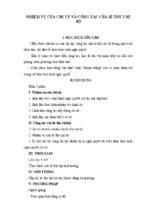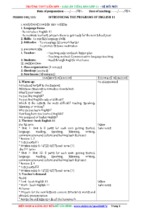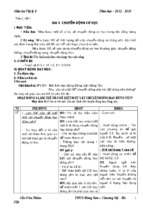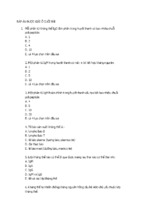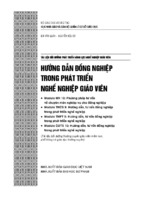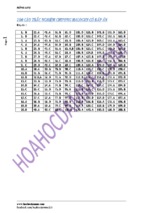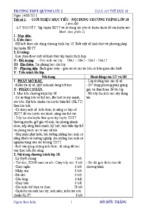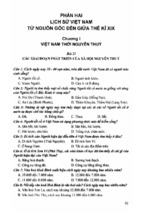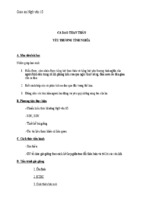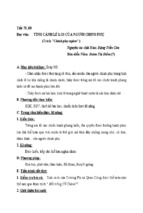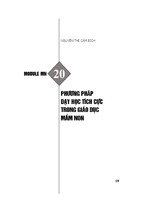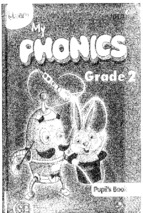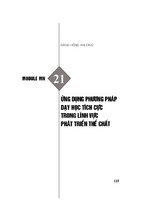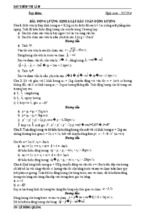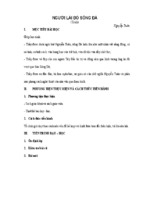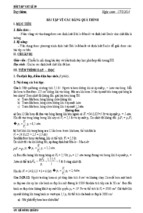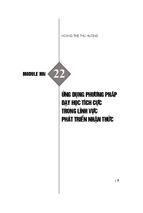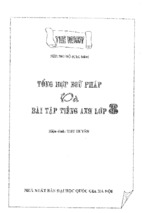WEEK:20
Period: 55
Preparing date:
Teaching date:
Unit 7: TRAFFIC
Lesson 1: Getting started
I./. OBJECTIVE: By the end of the lesson, Ss will be able to know some words,
phrases related to traffic topic. The usage of “How” to ask about means of transport.
1. Knowledge:
a. Vocabulary: - The lexical items related to the topic “ traffic”
b. Grammar: It indicating distance, used to.
2. Skills: Practicing skills
3. Attitude: - Positive about traffic.
- Students know how to learn English in right way.
- Ss are interested in doing exercises.
4. Competences:
- Co-operation
- Self- study
- Using language to talk about traffic.
II./.PREPARATION:
1.Teacher: book, planning, picture, laptop, projector
2.Students: books, notebooks
III./. TEACHING METHODS: Communicative approach, group Ss and T’s activities,
play as a character, teaching methods with game, teaching methods by visual, teaching
methods by practising, discussion group, technical present….
IV./.PROCEDURE:
Ss’ and T’s activities
1. Warm up.
- T introduces the topic “ Traffic”
Ask: How/ By what means do you go to
school every day?
On foot? By bicycle? By bus? On your
parents’ motorbike…
- What means of transport is faster? What
mean is safer? What means do you like
most?Why?
- What can you see on the way to school
every day?
- Who are Mai and Oanh?
- What may they talk about?
Contents
1
+ Play the recording. Ss listen and read.
2. Getting started
E1-a: Ss work independently or in pairs to
choose the correct answer to the questions.
T then checks their answers, and gives
explaination if necessary.
b- Ss work in pairs. T lets them check the
answers in pairs or groups, then gives the
keys. If there’s time, call some pairs to
read the questions and give answers.
1. Getting started
a. Choose the correct answer.
1. B
2. A
3. B
4.
b. Answer the following questions.
1. She played with her brother/ stayed at
home.
2. It’s about 2 kilometers.
3. She usually goes to school with her dad.
4. Because sometimes there are traffic jams
5. She goes to school by bike.
c. Can you find the following in the
conversation? Do you know what they
mean?
1. to have someone’s attention.
2. when you strongly support or agree with
something.
3. very excited and keen to do something.
C- Colloquial expressions.
Tell Ss to refer back to the conversation to
find the phrases. Ss practise saying them
together ( T plays the recording again if
necessary). Explain the meaning to the Ss,
then give some examples.
d. Ask Ss to role-player the short
conversations in pairs before creating their
short role-plays. More able Ss can try to
extend the conversation.
d. Work in pairs. Make short role-plays
with the expressions above. Then practice
them.
Example: - How about cycling to school
with me tomorrow?
- Great idea!
3. Doing
2. Means of transport.
E2. Ss work in pairs and write the means
of transport under the right pictures. Then
T lets Ss read each word correctly. Check
and correct their pronunciation.
Write the words using the first letter
given.
1. bike/ bicycle
2. bus
3. plane
4. boat
5. ship
6. train
7. motorbike
8. car
3. Match a verb on the left with a means
E3. Ss work individually to do the task,
2
and write their answers in their notebooks.
T checks their answers.
of transport on the right. There may be
more than one correct answer.
1. ride a bike
2. drive a car
3. fly by plane 4. sail on/ in a boat
5. get on/ get off a bus/ a train/ a bike/ a
motorbike.
4. Let Ss stand up and go round the class to 4. Find someone in your class who never.
ask everyone the question:
- How often do you walk to school/ go to
Ss have to take notes, and then some of
school by bus…?
them report their result to the class.
- Do you (often walk to school/ go to
school by bus?
4.Further practice:
- Lets sts summarize the content of the
lesson
5.Production:
-Learn new words and phrases
Prepare A closer look 1.
---------------------------o0o--------------------------------WEEK:20
Preparing date:
Period: 56
Teaching date:
Unit 7: TRAFFIC
Lesson 2: A closer look 1
I./. OBJECTIVE: By the end of the lesson, Ss will be able to use the lexical items
related to the topic “Traffic”. Pronounce sounds /e/, /ei/ correctly in isolation and in
context.
1. Knowledge:
a. Vocabulary: - The lexical items related to the topic “ traffic”
b. Grammar: It indicating distance, used to.
2. Skills: Practicing skills
3. Attitude: - Positive about traffic.
- Students know how to learn English in right way.
- Ss are interested in doing exercises.
4. Competences:
- Co-operation
- Self- study
- Using language to talk about traffic.
II./.PREPARATION:
1.Teacher: book, planning, picture, laptop, projector
2.Students: books, notebooks
3
III./. TEACHING METHODS: Communicative approach, group Ss and T’s activities,
play as a character, teaching methods with game, teaching methods by visual, teaching
methods by practising, discussion group, technical present….
IV./.PROCEDURE:
Ss’ and T’s activities
1. Warm up.
- Brainstorm the Ss: let them give all road
signs they see every day on the way to
school, or elsewhere, and all the words
they know related to the topic of traffic and
transport. Encourage them to say out as
many words as possible.
Contents
2.VOCABULARY
I- Vocabulary
ROAD SIGNS
1. Have you seen these road signs? Talk
about the meaning of the signs below
with a partner.
1. Ss work in pairs to talk about the
meaning of the road signs, then write out
their answers.
2. Ss work individually to label the road
signs in 1 with the words/ phrases.
Look out: There are usually three kinds of
signs: informative, prohibitive, and
warning.
2. Label the signs in 1 with the words/
phrases below.
1. trafic lights.
2. no parking
3. no right turn
4. hospital ahead
5. parking
6. cycle lane
7. school ahead
8. no cycling
Look out!
- A sign within a red triangle will warn
you of something.
- Signs with red circle are mostly
prohibitive- that means you can’t do
something.
- Signs in blue are usually to give
information.
3. Let Ss work in pairs and talk about the
3. Work in pairs. Discuss which of the
traffic signs they see on the way to school ( signs you see on the way to school.
or else). T goes around and gives assitance Example:
if necessary, and check their answers.
A: On the way to school, I can see a “ no
left turn” sign.
B: On my way to school there is a hospital,
so I can see a “hospital ahead” sign.
4
3.PRONUNCIATION
4. First, T give examples of the sounds /e/,
/ei/. Let Ss practise the sounds together.
Ask Ss to observe the T’s mouth and listen
to the teacher for these two sounds
carefully. Play the recording and let Ss
listen and repeat as many times as
required. Correct their pronunciation.
II- PRONUNCIATION
/e/ /ei/
4. Listen and repeat. Pay attention to
sounds /e/, /ei/
/e/: left, ahead, present, helicopter, centre,
never, seatbelt
/ei/: plane, way, station, train, indicate,
mistake, pavement, break.
5. Play the recording 2 or 3 times. Help Ss
distinguish the sounds /e/ , /ei/ and
recognize all the words with the two
sounds, then underlined them as assigned
5. Listen to these sentences carefully.
Single-underline the words with sound
/e/, and double-underline the words with
sound /ei/
/e/: 1. ever
/ei/: break, way
2. very
railway, station
3. 0
always, obey, safety
4. left, when
UK
5. next
They, waiting, train
6. Read a loud
6. Refer back to the page 8. Ask Ss to find
all the words having sounds /e/, /ei/
4.Further practice:
- Lets sts summarize the content of the
lesson
5.Production:
-Learn new words and phrases
Prepare A closer look 2.
---------------------------o0o--------------------------------WEEK:20
Period: 57
Preparing date:
Teaching date:
Unit 7: TRAFFIC
Lesson 3: A closer look 2
I./. OBJECTIVE: By the end of the lesson, Ss will be able to use “it” for distances, use
“ used to” to talk about past habit or state.
1. Knowledge:
a. Vocabulary: - The lexical items related to the topic “ traffic”
b. Grammar: It indicating distance, used to.
5
2. Skills: Practicing skills
3. Attitude: - Positive about traffic.
- Students know how to learn English in right way.
- Ss are interested in doing exercises.
4. Competences:
- Co-operation
- Self- study
- Using language to talk about traffic.
II./.PREPARATION:
1.Teacher: book, planning, picture, laptop, projector
2.Students: books, notebooks
III./. TEACHING METHODS: Communicative approach, group Ss and T’s activities,
play as a character, teaching methods with game, teaching methods by visual, teaching
methods by practising, discussion group, technical present….
IV./.PROCEDURE:
Ss’ and T’s activities
Contents
1. Warm up.
Chatting: You have already learned it as
the formal subject to indicate time and
weather, climate,…In this unit, it appears
to indicate distance
2. Grammar 1:
It indicating distance
I. It indicating distance
- T explains, then give example
- We can use it in the position of the
subject to indicate distance
1. Let Ss work by themseves and write
1. Write sentences with it. Use these
down the sentences. T observes and help
cues.
when and where necessary. After that ask
1. It is about 700 metres from my house to
some Ss to read their sentences. T corrects Youth Club
Ss’ mistakes.
2. It is about 5 km from my home village
2. Ss work in pairs. They ask and answer
to the nearest town.
qustions about distances in their
3. It is about 120 km from Ho Chi Minh to
neighbourhood, following the example.
Vung Tau.
Encourage them to talk as much as
4. It is about 384,400 km from the Earth to
possible. T corrects their answers, and their the Moon.
pronunciation and intonation.
5. It is not very far from HaNoi to Noi Bai
Airport.
2. Work in pairs. Ask and answer
questions about distances in your
neighbourhood.
Example:
6
A: How far is it from your house to
school?
B: It’s about a kilametre.
3. Grammar 2:
II- Used to
- We use used to to describe an action or a
state that happened regularly in the past but
does not happen at present.
Example: There used to be many trees on
the street, but now there are only shops.
Form:
(+) S + used to + V
(-) S + didn’t use to + V
(?) Did + S + use to
Watch out: In questions and negative
sentences, the final “d” in used is dropped.
3. Complete the sentences with used to
or use to and the verbs in the box below.
be ride play go
feel
1. used to ride
2. used to be
3. used to go
4. Did…use to play
5. did…..not use to feel
4. Rewrite the sentences using used to.
1. My mum used to live in a small village
when she was a girl.
2. There did not use to be (as) many
vehicles on the road.
3. We used to cycle to school two years
ago.
4. Now there are more traffic accidents that
there used to be.
Used to
Explain to the Ss that used to is the same
form for all persons. It is used to discribe
an action, a habit or a state that happened
regularly in the past, but does not happen
now.
3. Ss work independently, writing down
the answers. Then let them work in groups
to check and say out the sentences. T goes
round giving help when and where
necessary. Some Ss may write their
answers on the boards. Other Ss give
comments and T give corrections.
4. Let Ss work individually to rewrite the
sentences in their notebooks.
While Ss do their task, T goes round to
monitor the whole class. When Ss finish
their task, call some to read out their
sentences. Let others give comments, T
corrects mistakes if necessary.
5. My uncle used to be a bus driver some
year ago, but now he has a desk job.
5. Work in groups. Did you use to do
those things? Ask and answer.
Example: Did you use to play marbles?
Yes, I did
…………
5. Ss work in groups. They take turns to
ask and answer questions. Then T may ask
some Ss to report their result to the class.
One S may report to the class.
4.Further practice:
7
- Lets sts summarize the content of the
lesson
5.Production:
- Do exercise part A, B workbook
Prepare: Communication
---------------------------o0o--------------------------------Kiểm tra ngày tháng
năm 2018
…………………………………………………….
……………………………………………………
WEEK:21
Preparing date:
Period: 58
Teaching date:
Unit 7: TRAFFIC
Lesson 4: Communication
I./. OBJECTIVE: By the end of the lesson, Ss will be able to know names of some
countries and some strange laws in other countries.
1. Knowledge:
a. Vocabulary: - The lexical items related to the topic “ traffic”
b. Grammar: It indicating distance, used to.
2. Skills: Practicing skills
3. Attitude: - Positive about traffic.
- Students know how to learn English in right way.
- Ss are interested in doing exercises.
4. Competences:
- Co-operation
- Self- study
- Using language to talk about traffic.
II./.PREPARATION:
1.Teacher: book, planning, picture, laptop, projector
2.Students: books, notebooks
III./. TEACHING METHODS: Communicative approach, group Ss and T’s activities,
play as a character, teaching methods with game, teaching methods by visual, teaching
methods by practising, discussion group, technical present….
IV./.PROCEDURE:
Ss’ and T’s activities
1. Warm up
- Have you ever heard about strange laws
Contents
8
in other countries?
2. Comunication 1:
- Pre- teach vocabulary.
- First, have Ss read the new vocabulary
after the teacher saying that they will
appear in the task that follow. Explain their
meaning.
I- Extra vocabulary.
roof:
nóc, mái nhà
illegal:
bất hợp pháp, trái luật
Laws:
luật, phép tắc
Reverse:
đảo, nghịch, lùi xe
Right-handed: thuận tay phải
II- Practice
1: Look at the flags of some countries.
1: Ss work in groups and give the names of Give the names of these countries.
the five countries.
1. The UK
2. Australia
3. India
4. Thailand
5. Malaysia
2. Now listen and check your answers.
2. Play the recording. Ss listen carefully
Complete the blanks. Share your answer
and check their answer to 1. Then T gives with a partner.
the correct answers
Reasons this happened:
- Play the recording again. Let Ss complete 1. some countries used the same system as
the table by themselves, then share their
UK.
answer with a partner. T goes round the
2. many people are right-handed ( so on the
class to give support if necessary.
left-hand side, it is easier for them to use a
sword or something when they are on
horseback – in the past)
3. Look at the strange driving laws
below. Five of them are true, but one is
false. In pairs, can you find the fasle
driving law?
- “In France, you can only reverse your car
on Sundays”. This sentence is false!
3. Comunication 2:
3. Ss work in pairs, discussing to find one
false driving law.
T may ask the question: Which one do you
think seems most unreasonable? Then let
Ss think and give the answer.
4. Now, work in groups. Discuss the laws
and put them in order from the trangest
(1) to the least strange (5)
The groups may have different results
4. Ss work in groups and dis cuss the laws
in 3 and put them in order from the
strangest ( N01) to the least strange ( N05).
T may ask Ss to explain why.
4.Further practice:
- Lets sts summarize the content of the
9
lesson
5.Production:
- Do exercise part C workbook
Prepare: Skills 1
WEEK:21
Period: 58
---------------------------o0o--------------------------------Preparing date:
Teaching date:
Unit 7: TRAFFIC
Lesson 4: Communication
I./. OBJECTIVE: By the end of the lesson, Ss will be able to read for specific
information about traffic rules/ laws. Talk about obeying traffic rules/ laws, and how to
use the road safely.
1. Knowledge:
a. Vocabulary: - The lexical items related to the topic “ traffic”
b. Grammar: It indicating distance, used to.
2. Skills: Practicing skills
3. Attitude: - Positive about traffic.
- Students know how to learn English in right way.
- Ss are interested in doing exercises.
4. Competences:
- Co-operation
- Self- study
- Using language to talk about traffic.
II./.PREPARATION:
1.Teacher: book, planning, picture, laptop, projector
2.Students: books, notebooks
III./. TEACHING METHODS: Communicative approach, group Ss and T’s activities,
play as a character, teaching methods with game, teaching methods by visual, teaching
methods by practising, discussion group, technical present….
IV./.PROCEDURE:
Ss’ and T’s activities
1. Warm up
- Chatting: Look at the picture. What can
you see in the picture?
2. Reading.
1. T tells Ss to look at the picture and say
why it is dangerous.
Contents
I- Reading.
1. Look at the picture. Can you see
anything that is dangerous?
10
Example: It is dangerous to ride a
motorbike on the pavement.
2. Ss work in pairs to do the matching. T
checks their results.
Then T asks Ss which they can see in the
picture in 1.
2. Now match these words to make
common expressions.
1. g 2. d 3. b 4. c
5. a 6. h 7. f
8.e
3. Ss work in group. Tell them to answer
the question:
When you are a road user, what should
you Not do?
Then they make a list to compare with
other groups.
T may give some cues: not pay attention,
not look around, go in red light,….
3. Answer the following question.
- not pay attention
- not look around
- not go in red light,..
+ Make a list:
4. Tell Ss to read the passage two or three
times. Set a strist time limit to ensure Ss
read quickly for specific information.
Explain the new words and clarify
anything difficult. T may ask questions to
see if Ss understand the passage.
5. Ask Ss to read the passage again, than
they work with a partner to answer the
questions.
4. Read the following text and do the
tasks below.
3. Speaking
6. Ss do the class survey. After that call
some Ss to report to the class.
II- Speaking
6. Class survey. Ask your classmates the
question.
How do you go to school every day?
+ Make a list of the means of transport that
is used the most, and use the least.
7. Read the following sentences. In
groups, discuss who is using the road
7. Allow some time for Ss to read
individually. Then they work in groups to
5. Answer these question.
1. We should cross the street at the zebra
crossing.
2. He/ She must always fasten the seabelt.
3. No, He/ She shouldn’t. Because it is
dangerous.( He/ She may cause an
accident.)
4. We must give a signal.
5. Because the other road users can see them
clearly and avoid crashing into them.
11
discuss who is using the raod safely, and
who is acting dangerously, and give
reasons.
safely, and who is acting dangerously.
Give reasons.
1. safely
2. dangerously ( because he is likely to have
an accident)
3. safely
4. dangerously ( it is difficult for him to see
the road properly, and to ride)
5. dangerously ( a car or motorbike may
crash into him)
6. dangerously ( She may have an accident
if something happeneds unexpectedly.)
4.Further practice:
- Lets sts summarize the content of the
lesson
5.Production:
- Do exercise part D workbook
- Prepare: Skills 1
WEEK:21
Period: 59
---------------------------o0o--------------------------------Preparing date:
Teaching date:
Unit 7: TRAFFIC
Lesson 5: Skills 1
I./. OBJECTIVE: By the end of the lesson, Ss will be able to listen to get information
about traffic problems in big city, write a paragraph about traffic problems in a city/ an
area.
1. Knowledge:
a. Vocabulary: - The lexical items related to the topic “ traffic”
b. Grammar: It indicating distance, used to.
2. Skills: Practicing skills
3. Attitude: - Positive about traffic.
- Students know how to learn English in right way.
- Ss are interested in doing exercises.
4. Competences:
- Co-operation
- Self- study
- Using language to talk about traffic.
II./.PREPARATION:
12
1.Teacher: book, planning, picture, laptop, projector
2.Students: books, notebooks
III./. TEACHING METHODS: Communicative approach, group Ss and T’s activities,
play as a character, teaching methods with game, teaching methods by visual, teaching
methods by practising, discussion group, technical present….
IV./.PROCEDURE:
Ss’ and T’s activities
Contents
1. Warm up.
- Show pictures of traffic problems in big
cities.
2. Listening.
I- Listening.
Traffic problems in a big cities
1. Ss work in groups. They study the
1. Work in groups. Where do you think
picture and answer the tow questions.
this picture was taken? Why is it special?
- In a big city…..
2. Tell Ss to look at the newspaper
2. Look at the following headline and
headline and check their answers.
check your answers.
- In Brazil
- long traffic jam ( very long line of
vehicles).
3. Play the recording one or two times. Ask 3. Now listen to the passage and choose
Ss to listen carefully and circle the correct the correct answer.
answers.
1. B
2. C
3. A
4. C
3. Writing:
- What do you think about traffic problems
in big cities in Viet Nam are.
4. Have Ss look at the pictures, read the
pgrases and tick the problems
Then Ss write full sentences. Call some Ss
to write on the board. Others give
comments. T gives corrections.
5. Tell Ss to study the sentences they have
written, then practise writing the
II- Writing
4. Tick the traffic problems in big cities in
Viet Nam.
Picture: 1,2,3,4,6
Writing:
- There are too many vehicles ( on the
road).
- Many roads are narrow and bumpy
- There are traffic accidents every day.
- Many young children ride their bikes
dangerously.
5. Write a paragraph about the traffic
problems where you live, or in a town, or
13
paragraph.
Tell Ss to use proper connector: first/
firstly, second/ secondly, ……and pay
attention to spelling and punctuation.
- Collect some Ss’ writing papers and mark
them, then give comments to the class.
4.Further practice:
- Lets sts summarize the content of the
lesson
5.Production:
- Do exercise workbook
- Prepare: Looking back
a city you know well. Use the cues above,
and the following outline.
Introduction:
Problem1:
Problem 2:
Problem 3:
Conclusion: ( Reason or advice/
suggestion)
Suggested writing:
There are many traffic problems in my
city. First, there are too many vehicles on
the road. Second, Many roads are narrow
and bumpy. Last but not least, many young
people ride their bikes dangerously.
Therefore, there are many traffic accidents
every day. In order to reduce these
problems, we must strictly obey all the
traffic rules
---------------------------o0o--------------------------------Kiểm tra ngày tháng
năm 2018
…………………………………………………….
……………………………………………………
WEEK:22
Period: 61
Preparing date:
Teaching date:
Unit 7: TRAFFIC
Lesson 7: Looking back and project
I./. OBJECTIVE: By the end of the lesson, Ss can use what they have learnt during the
unit to help them answer the questions. Ss need to see how for they have progressed, and
which areas need further practice.
1. Knowledge:
a. Vocabulary: - The lexical items related to the topic “ traffic”
14
b. Grammar: It indicating distance, used to.
2. Skills: Practicing skills
3. Attitude: - Positive about traffic.
- Students know how to learn English in right way.
- Ss are interested in doing exercises.
4. Competences:
- Co-operation
- Self- study
- Using language to talk about traffic.
II./.PREPARATION:
1.Teacher: book, planning, picture, laptop, projector
2.Students: books, notebooks
III./. TEACHING METHODS: Communicative approach, group Ss and T’s activities,
play as a character, teaching methods with game, teaching methods by visual, teaching
methods by practising, discussion group, technical present….
IV./.PROCEDURE:
Ss’ and T’s activities
1. Warm up.
- Chatting: What is the topic of Unit 7.
2. Looking back:
Vocabulary
1. Ss do this task individually to write the
meaning below each sign. T corrects their
mistakes and lets them read the words
correctly.
- Then let Ss work in groups and put the
signs into the correct boxes.
2. Let Ss work in pairs. Tell Ss to write the
answers in their notebooks. T checks their
answers.
GRAMMAR
3.Have Ss work in pairs or in groups and
write their answers in their notebooks. T
Contents
I- Vocabulary
1. What do these signs mean? Write the
meaning below each sign. Then put them
into the correct box.
1. Traffic lights
2. School ahead
3. Hospital ahead 4. Cycle lane
5. Parking
6. No parking
7. left turn only
8. No cycling
Prohibition signs: 6,8
Warning signs: 1,2, 7
Information signs: 3,4,5
2. Write the names of means of transport
in the word web below. Then draw lines
joining the correct verbs to the transport.
- Suggestion: bicycle, motorbike, car, bus,
taxi, train, plane, boat, ship…
II- Grammar
3. Change the sentences according to the
prompts in brackets.
15
checks their answers.
1. Did you use to go to school on foot?
2. Mr. Van didn’t use to ride his motorbike
dangerously.
3. Did the streets use to be cleaner and
more peaceful?
4. I used to go out on Sundays.
5. They didn’t use go to on holiday
together.
4.Ss work individually first to write the
4. Write sentences using these cues.
sentences. Then they work in pairs to swap 1. It is over 100 km from my home-town to
their sentences. T gives correction and
HCM city.
calls some Ss to read the sentences aloud.
2. It is about 25 km to my grandparents’s
house.
3. I used to ride a small bike in the yard
before my flat.
4. There used to be a bus station in the city
centre, but it was/ has been moved to the
suburbs.
5. Children must learn about road safety
before they are allowed to ride a bike on
the road.
COMMUNICATION
III- Communication
5. Ss read the questions and answers once 5. Match the questions 1-6 with the
or twice ( they can read alound), then
answers a-f
match them.Ss work in pairs and role- play 1. b 2. a 3. e 4. d 5. f 6. c
the questions and answers, then write all
Finish! Now I can…
sentences in their notebooks.
Talk about road signs and means of
Finished!
transport
Finally ask Ss to complete the selfUse it to talk about distance
assessment. Identify any difficulties and
Use used to to talk about a past habit
weak areas and provide further practice if
Write a paragraph about traffic problems.
need be.
3. PROJECT
Ss work in groups.
4.Further practice:
- Lets sts summarize the content of the
lesson
5.Production:
- Make some traffic signs of your own out
of paper, cardboard or other materials.
- Prepare: Unit 8- Getting started
16
WEEK:22
Period: 62
---------------------------o0o--------------------------------Preparing date:
Teaching date:
Unit 8: FILM
Lesson 1: Getting -started
I./. OBJECTIVE: By the end of the lesson, Ss will listen and read about topic” What
film shall we see?”. Use the lexical items related to the topic “ Films”
1. Knowledge:
a. Vocabulary: - The lexical items related to the topic “ films”
b. Grammar: ed and ing adjectives, connectors.
2. Skills: Practicing skills
3. Attitude: - Positive about film.
- Students know how to learn English in right way.
- Ss are interested in doing exercises.
4. Competences:
- Co-operation
- Self- study
- Using language to talk about film.
II./.PREPARATION:
1.Teacher: book, planning, picture, laptop, projector
2.Students: books, notebooks
III./. TEACHING METHODS: Communicative approach, group Ss and T’s activities,
play as a character, teaching methods with game, teaching methods by visual, teaching
methods by practising, discussion group, technical present….
IV./.PROCEDURE:
Ss’ and T’s activities
Contents
1. Warm up
- Write the title on the board “Films”.
Elicit any information Ss know about films
by asking about types of film they know,
the latest films they have seen, their
favourite films and film stars.
- What the picture might show or what the
conversation might be about.
2. Getting started
I- Getting started
1. Ask Ss questiona about the picture:
1. Listen and read
- Where are Phong and his sister Mai?
a. Read the conversation again and and
What might be happening to them? What
answer the questions.
17
are thet doing? What are they talking
about?
- Can you guess what kind of films Phong
and Mai would like to see.
- Have you ever gone to see a film with
your brothers/ sisters? When and where?
What film did you see then? How did you
feel then?
- Plat the recording. Ss listen and repeat.
a. First, have Ss work independently. Then
allow them to share answers before
discussing as a class.
b. First, Ask Ss not to look at the book and
try to remember what questions Mai asks
Duong about the film they are going to see.
Then let Ss open their books and check
their answers.
1. b
2. a
3.a
4. c
5. b
b. Find the questions in the conversation
that ask about Coconut Crazy. Then
listen, check and repeat the question.
a. What kind of film is it?
b. Who does it star?
c. What is it about?
d. What do critics say about it?
3. Doing:
2. Have Ss quickly match the types of film 2. Match the types of films with their
with their definitions. Then play the
definitions. Then listen, check and repeat.
recording for Ss to check their answers.
1. d 2. f 3. a 4. c 5. b 6. e 7. h 8.g
- Do you often see a sci-fi/ horror film…..?
3a. Have Ss work independently, filling in
the table with the information of the film
they have seen recently. Remind them to
use the words and phrases they have learnt
in 2 and from the conversation in 1.
3a. Think of a film. Fill in the blank
below.
Type of film……………….
Actors/ stars……………….
The plot……………………
Reviews……………………
b. First, model this activity with a more
able Ss. Then ask Ss to work in pairs. T
may go around to help weaker Ss. Call
some pairs to practice in front of the class.
b. In pairs, interview each other and try to
guess the film.
Example:
A: What kind of film is it?
B: It’s an action film
A: Who does it satr?
B: It stars Daniel Craig.
A: What is it about?
B: It’s about a spy called 007.
A: Is it Skyfall?
18
B: Yes!
4.Further practice:
- Lets sts summarize the content of the
lesson
5.Production:
- Listen and read the getting started again
- Prepare: Unit 8- A closer look 1
---------------------------o0o--------------------------------WEEK:22
Period: 63
Preparing date:
Teaching date:
Unit 8: FILM
Lesson 2: A closer look 1
I./. OBJECTIVE: By the end of the lesson, Ss will use the lexical items related to the
topic “Films”. Know the meaning and how to use –ed and –ing adjectives. Pronounce
correctly the –ed ending in verbs.
1. Knowledge:
a. Vocabulary: - The lexical items related to the topic “ films”
b. Grammar: ed and ing adjectives, connectors.
2. Skills: Practicing skills
3. Attitude: - Positive about film.
- Students know how to learn English in right way.
- Ss are interested in doing exercises.
4. Competences:
- Co-operation
- Self- study
- Using language to talk about film.
II./.PREPARATION:
1.Teacher: book, planning, picture, laptop, projector
2.Students: books, notebooks
III./. TEACHING METHODS: Communicative approach, group Ss and T’s activities,
play as a character, teaching methods with game, teaching methods by visual, teaching
methods by practising, discussion group, technical present….
IV./.PROCEDURE:
Ss’ and T’s activities
Contents
1. Warm up
Chatting: Do you know the adjectives
which are often used to describe films?
19
2. – Vocabulary:
1. First, hace Ss work independently. Then,
ask them to share their answers with one or
more partners. With weaker class, ask for
translation of some adjectives in the box to
check their understanding. Ask Ss to make
some examples with the adjectives they
have learnt.
Remember: -ed and – ing adjectives
Ask Ss to study the Remember Box.
2. Have Ss compare the table individually.
Then have some Ss write their answers on
the board before checking with the whole
class.
I- Vocabulary
1. The following are adjectives which are
often used to describe films. Can you add
some more?
1. hilarious
2. moving
3. boring
4. gripping
5. shocking
6. scary
7. violent
8. entertaining
* Remember: -ed and –ing adjectives
4.(a+b) First, model this activity with some
more able Ss. Then, ask Ss to work in
pairs. T may go around to help weaker Ss.
Call some pairs to practise in front of the
class.
4a. Work in pairs. Look at the questions
below. Tell your partner how you felt,
using –ed adjectives.
Example: I felt terrified before my last
Maths test.
4b. Now use –ing adjectives to describe
these things and experiences in your life.
Example: The last film I saw was called
Norwegian Wood. It was really moving.
II- Pronunciation
2. Complete the table with the –ed and –
ing forms of the adjectives.
1. interested
2. embarrassing
3. exciting
4. disappointed
5. exhausted
6. surprising
7. confused
8. frightening
3. Ask Ss to do the exercise individually
3. Choose the correct adjectives.
and then check with the whole class. When 1. moving
2. frightened
checking, ask Ss to refer to the Remember 3. disappointed 4. amazed
Box to make the meanings of the
5. terrified
adjectives clearer to them.
3.Pronunciation
5. T models the sounds /t/ /d/, and /id/ in
different words with the ending –ed. Play
the recording and ask Ss to listen and
repeat the words, paying attention to the
sounds /t/, /d/, and /id/ at the end of each
word. T may play the recording as many
times as necessary. Then, ask Ss to put the
words in the correct columns while they
listen. Ss compare their answers in pairs. T
checks.
5. Listen and repeat the verbs. Pay attention to the
sounds /t/, /d/, and /id/ at the end of each verb.
/t/
watched
danced
walked
* Remember:
20
/d/
waited
needed
hated
/id/
played
bored
closed
- Xem thêm -


